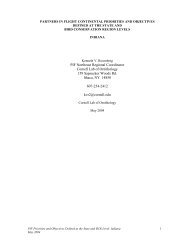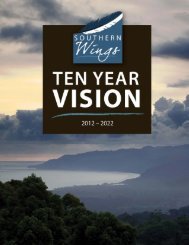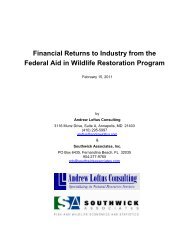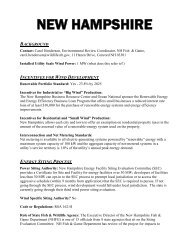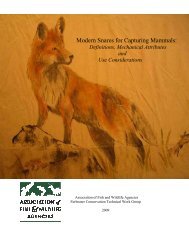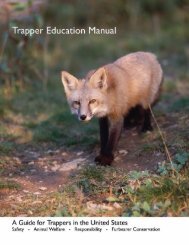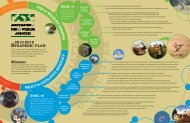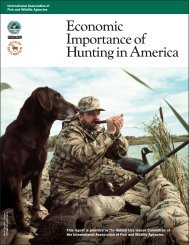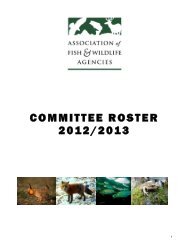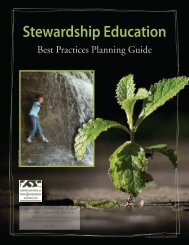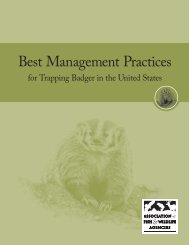Muskrat - Association of Fish and Wildlife Agencies
Muskrat - Association of Fish and Wildlife Agencies
Muskrat - Association of Fish and Wildlife Agencies
You also want an ePaper? Increase the reach of your titles
YUMPU automatically turns print PDFs into web optimized ePapers that Google loves.
Best Management Practicesfor Trapping <strong>Muskrat</strong>s in the United StatesUpdated Edition 2010
Best Management Practices (BMPs) are carefully researched educational guides designedto address animal welfare <strong>and</strong> increase trappers’ efficiency <strong>and</strong> selectivity. The extensiveresearch <strong>and</strong> field-testing used to develop BMPs are described in the Introduction section<strong>of</strong> this manual. The evaluation methods used to develop BMPs have been st<strong>and</strong>ardized,enabling them to be easily updated <strong>and</strong> revised as new traps <strong>and</strong> techniques becomeavailable. All traps listed in the BMPs have been tested <strong>and</strong> meet performance st<strong>and</strong>ardsfor animal welfare, efficiency, selectivity, practicality <strong>and</strong> safety.Figure MK1. <strong>Muskrat</strong>(Ondatra zibethicus)Trapping BMPs provide options, allowing for discretion <strong>and</strong> decision making in thefield. BMPs are meant to be implemented in a voluntary <strong>and</strong> educational approach<strong>and</strong> do not present a single choice that can or must be applied in all cases. BMPs arethe product <strong>of</strong> ongoing work that may be updated as additional traps are identifiedthrough future scientific testing.MUSKRAT2The <strong>Muskrat</strong> at a GlanceCharacteristicsThe muskrat (Ondatra zibethicus) (Figure MK1) is a semiaquatic rodent <strong>and</strong> member<strong>of</strong> the Cricetidea family along with mice <strong>and</strong> voles. Adults weigh between 1 1 / 2 <strong>and</strong>4 pounds, <strong>and</strong> range from 16 to 25 inches in total length. Adult males are generallylarger than adult females. The muskrat has a laterally flattened tail <strong>and</strong> webbed hindfeet, indications <strong>of</strong> its aquatic nature. Pelage color varies from light brown to black.A thick waterpro<strong>of</strong> under-layer <strong>of</strong> fur is overlain by long, glossy guard hairs.Range<strong>Muskrat</strong>s inhabit all <strong>of</strong> North America except the Eastern Gulf states, <strong>and</strong> much <strong>of</strong> Nevada,California <strong>and</strong> Texas. The species is rarely found in Mexico, but the range extends north tothe Arctic Circle. <strong>Muskrat</strong>s were introduced to Europe early in the 20th century, <strong>and</strong> nowinhabit many parts <strong>of</strong> Eurasia.HabitatThe muskrat is an aquatic mammal <strong>and</strong> prefers to inhabit still or slow-moving bodies <strong>of</strong>water. Common habitat types are marshes, sloughs, streams, lakes, ponds <strong>and</strong> variousother types <strong>of</strong> wetl<strong>and</strong>s. Typically, they prefer freshwater, but in coastal areas, muskrats willinhabit brackish marsh. Where bank slope is adequate, muskrats <strong>of</strong>ten build dens in thebank <strong>of</strong> a water body, but commonly build houses <strong>of</strong> vegetation in marshes <strong>and</strong> sloughs.Food HabitsThe muskrat is chiefly herbivorous, but in some parts <strong>of</strong> its range it is known to eat freshwaterclams, crayfish, fish, frogs <strong>and</strong> other small animals. When consuming aquatic vegetation,muskrats <strong>of</strong>ten eat the shoots, leaves, bulbs <strong>and</strong> rootstocks <strong>of</strong> plants. They preferemergent vegetation such as cattails, three-cornered sedge <strong>and</strong> bulrush, but <strong>of</strong>ten feed onsubmergent vegetation as well. <strong>Muskrat</strong>s are also known to eat corn <strong>and</strong> other agricultural plantswhen available.ReproductionDepending on the geographic location <strong>of</strong> a population, a restricted breeding seasonmay occur (northern part <strong>of</strong> range), or breeding may occur year round (southern part <strong>of</strong>range). After mating, there is a gestation period <strong>of</strong> 28 to 30 days. A litter normally consists<strong>of</strong> three to nine young. The muskrat may birth up to six litters per year, though mosthave only two or three litters annually. Weaning occurs at three to four weeks after birth.Young are the same size as adults at six months <strong>and</strong> normally breed after the first year.<strong>Association</strong> <strong>of</strong> <strong>Fish</strong> <strong>and</strong> <strong>Wildlife</strong> <strong>Agencies</strong>
PopulationsPopulations vary considerably depending on habitat availability, geographic location, weatherconditions <strong>and</strong> variability in market dem<strong>and</strong>. <strong>Muskrat</strong> populations undergo regular cycles<strong>of</strong> fluctuations varying from five years in some parts <strong>of</strong> the United States to 10 to 14 yearsin others. The prolific reproductive capabilities <strong>of</strong> the muskrat help in recovery from anypopulation decline. <strong>Muskrat</strong>s may cause extensive damage in dikes, pond dams <strong>and</strong> otherhydraulic structures as a result <strong>of</strong> constructing bank dens.General Overview <strong>of</strong> Traps Meeting BMPCriteria for <strong>Muskrat</strong>s in the United StatesThree basic types <strong>of</strong> traps were tested for muskrats: foothold traps (for submersion setsonly), bodygrip traps <strong>and</strong> cage traps (Table MK1). Examples, brief descriptions <strong>and</strong>mechanical details <strong>of</strong> the various devices are given in the next section.Table MK1. Overview <strong>of</strong> traps meeting BMP criteria** for muskrats in the United States.Trap CategoryJaw/FrameCharacteristicsInside Jaw/FrameSpread at Dog*Inside Width at Jaw/Frame Hinge Posts*Coil-spring (Figure MK7a) Unmodified 3 11 / 16 31/ 2Longspring(Figures MK7b <strong>and</strong> MK8)PaddedDouble-jawUnmodified3 3 / 83 7 / 163 5 / 83 7 / 83 7 / 83 7 / 16Height <strong>of</strong>Trap Window*Width <strong>of</strong>Trap Window*FrameWire*SpringWire*Bodygrip(Figures MK9a – MK9f)4 1 / 4 – 5 41/ 4 – 43/ 43/ 16 –1/ 43/ 16 –1/ 4Total Dimensions*Length x Width x HeightDoor Size*Width x HeightMesh Size*/GaugeCage+(Figure MK10)24 x 7 x 7 7 x 71 x 112 gauge galvanized* Inches**Any size foothold traps or bodygrip traps with the above measurements or larger measurements,which are commonly used for muskrats, also meet BMP criteria for use in submersion sets for this species;foothold sizes commonly designated as 11,1, 1.5, 1.65, 1.75, 2, 3 <strong>and</strong> bodygrip sizescommonly designated as 110, 120, 160 <strong>and</strong> 220.+ Cage traps <strong>of</strong> these dimensions meet BMP criteria for live restraint or use in submersion sets.Best Management Practices for Trapping in the United States3 MUSKRAT
General Considerations When Trapping <strong>Muskrat</strong>sFoothold Traps• Many currently-used trap models meet specifications for use in submersion sets• Loosening pan tension so that the pan moves freely may improve efficiency• Can be used to capture several furbearer speciesFigure MK2. Bodygrip, properstrike locationBodygrip Traps• Should be placed so that the rotating jaws capture the animal by closing on the top <strong>and</strong>bottom <strong>of</strong> the captured animal’s neck (Figure MK2)• Can be used in locations <strong>and</strong> in weather conditions where other traps are less effective• May not be appropriate in some areas (captures <strong>and</strong> kills animals, no release)Cage Traps• Can be used to capture several furbearer species• Can be used in baited sets or trailsets• Captures <strong>and</strong> holds animals alive, allowing for release or can be used in submersion setsFigure MK3a. Setting toolSafe Use <strong>of</strong> Bodygrip TrapsBy design, bodygrip traps must close with considerable force to humanely dispatch <strong>and</strong>efficiently capture wild furbearers. This is particularly true <strong>of</strong> larger sized <strong>and</strong> “magnum”type bodygrip traps. As a result, users should take special precautions to avoid potentialinjury when using these devices. Trappers should be familiar with the safe <strong>and</strong> efficientuse <strong>of</strong> bodygrip traps <strong>and</strong> these are best learned in trapper education courses.Figure MK3b. Using setting toolA setting tool (Figure MK3a) should be used to compress trap springs when setting large<strong>and</strong> magnum bodygrip traps. Use <strong>of</strong> a setting tool will not only make setting traps easier,it will make setting traps safer by allowing the trapper to keep h<strong>and</strong>s <strong>and</strong> fingersaway from the jaws (Figure MK3b). Most bodygrip traps that have double springs areequipped with spring latches that hold each spring compressed, <strong>and</strong> the trapper shoulduse these latches on both trap springs. A safety gripper (Figure MK4a) should also beattached to the jaws when the jaws are moved to the set position (Figure MK4b). Thiswill prevent the trap from accidentally closing. The above safety devices protect thetrapper <strong>and</strong> make it easier to set, position <strong>and</strong> anchor the trap safely. Safety devicesshould be disengaged only when the set is completed.Figure MK4a. Safety gripper Figure MK4b. Using safety gripperMUSKRAT 4<strong>Association</strong> <strong>of</strong> <strong>Fish</strong> <strong>and</strong> <strong>Wildlife</strong> <strong>Agencies</strong>
If you are accidentally caught in a bodygrip trap you need to know how to free yourself.A setting tool is the most effective means to freeing yourself <strong>and</strong> should be used to compressthe springs or jaws. You should always have one in reach when setting <strong>and</strong> placingbodygrip traps. In the event you are not able to reach one or use it with one arm, youshould always carry a four foot piece <strong>of</strong> rope. The rope should have a loop tied on oneend <strong>and</strong> should be stored in a pocket that can be easily accessed by either h<strong>and</strong>. Youcan use the rope to free yourself as follows:1) Thread the rope through the eyes <strong>of</strong> one <strong>of</strong> the springs (Figure MK5a).2) Bring the rope around <strong>and</strong> thread it back through the eyes a second time(Figure MK5b).3) Place your foot in the looped end <strong>of</strong> the rope <strong>and</strong> pull the other end with yourfree h<strong>and</strong> until you can set the safety latch for that spring. (Figure MK5c). You mayneed to do this to both springs to completely free yourself.Figure MK5a. Step 1 Figure MK5b. Step 2 Figure MK5c. Step 3Specifications <strong>of</strong> Traps Meeting BMP Criteriafor <strong>Muskrat</strong>s in the United StatesAs more capture devices are tested <strong>and</strong> new information becomes available, they willbe added to an updated list. Mechanical descriptions <strong>of</strong> tested traps are given as anaid to trappers or manufacturers who may wish to measure, build or modify traps tomeet these specifications (Figure MK6a <strong>and</strong> MK6b). Also, other commercially availabletraps, modified traps, or other capture devices not yet tested may perform as well as, orbetter than the listed BMP traps. References to trap names are provided to identify thespecific traps tested. The following list is provided for information purposes only<strong>and</strong> does not imply an endorsement <strong>of</strong> any manufacturer.Average mechanical measurements are rounded to the nearest 1 / 16 inch. Theremay be up to a 1 / 8 inch variation in specifications on the part <strong>of</strong> the manufacturer.Manufacturers use recognizable names, such as “No. 2” coil-spring, to identify certaintraps. However, there is no st<strong>and</strong>ardized system linking mechanical design featureswith trap names. The mechanical features <strong>of</strong> these traps are listed so that similar trapsmay be identified. The performance <strong>of</strong> anchoring systems was not specifically evaluated,however, methods <strong>of</strong> attachment are described for informational purposes.A=height B=widthInside jaw spreadInside widthat jaw hingepostsFigure MK6a. Coil-spring trapFigure MK6a. Bodygrip trap5 MUSKRATBest Management Practices for Trapping in the United States
Figure MK7a. Unmodified jaw coilspringtrap (open)Unmodified Jaws (Figures MK7a <strong>and</strong> MK7b)Average Mechanical Description <strong>and</strong> AttributesInside jaw spread (at dog): 3 11 / 16 inchesInner width: 3 3 / 16 inchesInside width at jaw hinge posts: 3 1 / 2 inchesJaw width: 3 / 8 inch smooth round jawJaw thickness: 1 / 8 inchMain trap springs: Two 0.113 inch diameter wire coil-springsBase plate: Not reinforcedPan stop: YesAny trap that has similar specifications may be considered a BMP trap regardless<strong>of</strong> br<strong>and</strong> or source <strong>of</strong> modification, although performance information on all otherBMP criteria (see Introduction: “Criteria for Evaluation <strong>of</strong> Trapping Devices” pages 4-6)needs to be considered as well. The trap tested was the Woodstream Victor No. 1coil-spring.Figure MK7b. Unmodified jaw doublelongspringtrap (open)Additional Information• For use in submersion sets only.• Chain attachment used in trap testing: six inch center-mounted with two swivels, onein-line shock spring, <strong>and</strong> anchored with a stake. When using submersion sets, chainlength should be short enough to prevent captured animals from resurfacing.• Selectivity features: Brass pan tension machine screw; pan tension was loosened so thatthe pan moved freely, <strong>and</strong> was checked <strong>and</strong> readjusted as needed after every capture.• Special considerations for practicality: This device also meets BMP criteria for raccoonsin the southeastern United States, <strong>and</strong> mink <strong>and</strong> nutria in submersion sets.Average Mechanical Description <strong>and</strong> AttributesInside jaw spread (at dog): 3 7 / 8 inchesInner width: 3 1 / 8 inchesInside width at jaw hinge posts: 3 7 / 16 inchesJaw width: 1 / 2 inchJaw thickness: 1 / 8 inchLength <strong>of</strong> main trap springs: 4 3 / 8 inchesThickness <strong>of</strong> main trap springs: 1 / 16 inchWidth <strong>of</strong> main trap springs: 1 1 / 2 inches narrowing to5/ 8 inchBase plate: Not reinforcedPan stop: YesAny trap that has similar specifications may be considered a BMP trap regardless<strong>of</strong> br<strong>and</strong> or source <strong>of</strong> modification, although performance information on all otherBMP criteria (see Introduction: “Criteria for Evaluation <strong>of</strong> Trapping Devices” pages 4-6)needs to be considered as well. The trap tested was the Sleepy Creek No. 11double-longspring trap.MUSKRAT 6<strong>Association</strong> <strong>of</strong> <strong>Fish</strong> <strong>and</strong> <strong>Wildlife</strong> <strong>Agencies</strong>
Additional Information• For use in submersion sets only.• Chain attachment used in trap testing: 12 inch center-mounted with two swivels,one in-line shock spring, <strong>and</strong> anchored with a stake. When using submersion sets,chain length should be short enough to prevent captured animals from resurfacing.• Selectivity features: Brass pan tension machine screw; pan tension was set so twopounds <strong>of</strong> pressure triggered the trap, <strong>and</strong> was checked <strong>and</strong> readjusted as neededafter every capture.• Special considerations for practicality: This device also meets BMP criteria for beaverin submersion sets <strong>and</strong> for restraining or submersion sets for river otter.Padded JawsAverage Mechanical Description <strong>and</strong> AttributesInside jaw spread (at dog): 3 3 / 8 inchesInner width: 3 1 / 4 inchesInside width at jaw hinge posts: 3 5 / 8 inchesJaw width: 5 / 8 inchJaw thickness: 3 / 8 inchLength <strong>of</strong> main trap springs: 5 inchesThickness <strong>of</strong> main trap springs: 1 / 16 inchWidth <strong>of</strong> main trap springs: 1 1 / 4 inches narrowing to5/ 8 inchBase plate: Not reinforcedPan stop: NoAny trap that has similar specifications may be considered a BMP trap regardless <strong>of</strong>br<strong>and</strong> or source <strong>of</strong> modification, although performance information on all other BMPcriteria (see Introduction: “Criteria for Evaluation <strong>of</strong> Trapping Devices” pages 4-6)needs to be considered as well. The trap tested was the Woodstream Oneida VictorNo. 11 double-longspring trap, padded.Additional Information• For use in submersion sets only.• Chain attachment used in trap testing: 18 inch corner-mounted, <strong>and</strong> anchored with astake. When using submersion sets, chain length should be short enough to preventcaptured animals from resurfacing.• Selectivity features: Pan tension was loosened so that the pan moved freely, <strong>and</strong>was checked <strong>and</strong> readjusted as needed after every capture.Best Management Practices for Trapping in the United States7 MUSKRAT
Figure MK8. Double-longspring trapwith double-jawDouble Jaws (Figure MK8)Average Mechanical Description <strong>and</strong> AttributesInside jaw spread (at dog): 3 7 / 8 inchesInner width: 3 1 / 8 inchesInside width at jaw hinge posts: 3 7 / 16 inchesJaw width: 1 / 2 inchJaw thickness: 1 / 8 inchLength <strong>of</strong> main trap springs: 4 3 / 8 inchesThickness <strong>of</strong> main trap springs: 1 / 16 inchWidth <strong>of</strong> main trap springs: 1 1 / 2 inches narrowing to5/ 8 inchBase plate: Not reinforcedPan stop: YesAny trap that has similar specifications may be considered a BMP trap regardless <strong>of</strong>br<strong>and</strong> or source <strong>of</strong> modification, although performance information on all other BMPcriteria (see Introduction: “Criteria for Evaluation <strong>of</strong> Trapping Devices” pages 4-6)needs to be considered as well. The trap tested was the Sleepy Creek No. 11 doublelongspring,double-jaw trap.Additional Information• For use in submersion sets only.• Chain attachment used in trap testing: 12 inch center-mounted with three swivels,one in-line shock spring, <strong>and</strong> anchored with a stake. When using submersion sets,chain length should be short enough to prevent captured animals from resurfacing.• Selectivity features: Brass pan tension machine screw; pan tension was set so twopounds <strong>of</strong> pressure triggered the trap, <strong>and</strong> was checked <strong>and</strong> readjusted as neededafter every capture.• Special considerations for practicality: This device also meets BMP criteria forrestraining <strong>and</strong> submersion sets for river otter, <strong>and</strong> submersion sets for mink, beaver<strong>and</strong> nutria.Bodygrip Traps (Figures MK9a, MK9b, MK9c, MK9d, MK9e<strong>and</strong> MK9f)Average Mechanical Description <strong>and</strong> AttributesHeight <strong>of</strong> trap window: 4 7 / 8 inchesWidth <strong>of</strong> trap window: 4 5 / 8 inchesDiameter <strong>of</strong> frame wire: 3 / 16 inchDiameter <strong>of</strong> spring wire: 3 / 16 inchAdditional clamping bar: None, but does have a magnum bend which eliminates thegab between the jaws when the trap is closed.Safety features: Spring latchesAny trap that has similar specifications may be considered a BMP trap regardless <strong>of</strong>br<strong>and</strong> or source <strong>of</strong> modification, although performance information on all other BMPcriteria (see Introduction: “Criteria for Evaluation <strong>of</strong> Trapping Devices” pages 4-6)needs to be considered as well. The trap tested was the Belisle Super X 120 bodygriptrap.MUSKRAT 8<strong>Association</strong> <strong>of</strong> <strong>Fish</strong> <strong>and</strong> <strong>Wildlife</strong> <strong>Agencies</strong>
Additional Information• Safety considerations: Use <strong>of</strong> setting tongs <strong>and</strong> safety gripper is recommended.• Special considerations for practicality: This trap also meets BMP criteria for marten<strong>and</strong> fisher.Average Mechanical Description <strong>and</strong> AttributesHeight <strong>of</strong> trap window: 4 5 / 8 inchesWidth <strong>of</strong> trap window: 4 3 / 4 inchesDiameter <strong>of</strong> frame wire: 3 / 16 inchDiameter <strong>of</strong> spring wire: 3 / 16 inchAdditional clamping bar: NoneSafety features: Spring latchesMost bodygrip traps approved inthis BMP were tested via computersimulation modeling relative toanimal welfare performance.As a result, trap anchoringinformation does not exist forthese traps. However, bodygriptraps should always be securelyanchored. Anchoring informationis provided on specific traps thatwere field tested.Any trap that has similar specifications may be considered a BMP trap regardless <strong>of</strong>br<strong>and</strong> or source <strong>of</strong> modification, although performance information on all other BMPcriteria (see Introduction: “Criteria for Evaluation <strong>of</strong> Trapping Devices” pages 4-6)needs to be considered as well. The trap tested was the B.M.I 120 bodygrip trap.Additional Information• Safety considerations: Use <strong>of</strong> setting tongs <strong>and</strong> safety gripper is recommended.Figure MK9a. Bélisle Super Xbodygrip (set)Average Mechanical Description <strong>and</strong> AttributesHeight <strong>of</strong> trap window: 4 5 / 8 inchesWidth <strong>of</strong> trap window: 4 3 / 4 inchesDiameter <strong>of</strong> frame wire: 3 / 16 inchDiameter <strong>of</strong> spring wire: 3 / 16 inchAdditional clamping bar: None, but does have a magnum bendSafety features: Spring latchesAny trap that has similar specifications may be considered a BMP trap regardless <strong>of</strong>br<strong>and</strong> or source <strong>of</strong> modification, although performance information on all other BMPcriteria (see Introduction: “Criteria for Evaluation <strong>of</strong> Trapping Devices” pages 4-6)needs to be considered as well. The trap tested was the B.M.I 120 Magnum bodygriptrap.Figure MK9b. B.M.I 120bodygrip trapAdditional Information• Safety considerations: Use <strong>of</strong> setting tongs <strong>and</strong> safety gripper is recommended.Best Management Practices for Trapping in the United States9 MUSKRAT
Figure MK9c. LDL bodygrip trapwith additional clampingbar (set)Average Mechanical Description <strong>and</strong> AttributesHeight <strong>of</strong> trap window: 4 3 / 4 inchesWidth <strong>of</strong> trap window: 4 3 / 4 inchesDiameter <strong>of</strong> frame wire: 3 / 16 inchDiameter <strong>of</strong> spring wire: 3 / 16 inchAdditional clamping bar: None, but does have a magnum bend which eliminates thegap between the jaws when the trap is closed.Safety features: Spring latchesAny trap that has similar specifications may be considered a BMP trap regardless <strong>of</strong>br<strong>and</strong> or source <strong>of</strong> modification, although performance information on all other BMPcriteria (see Introduction: “Criteria for Evaluation <strong>of</strong> Trapping Devices” pages 4-6)needs to be considered as well. The trap tested was the B.M.I. 126 Magnum bodygriptrap.Additional Information• Safety considerations: Use <strong>of</strong> setting tongs <strong>and</strong> safety gripper is recommended.• Special considerations for practicality: This device also meets BMP criteria for marten.Average Mechanical Description <strong>and</strong> AttributesHeight <strong>of</strong> trap window: 4 1 / 2 inchesWidth <strong>of</strong> trap window: 4 1 / 2 inchesDiameter <strong>of</strong> frame wire: 3 / 16 inchDiameter <strong>of</strong> spring wire: 3 / 16 inchAdditional clamping bar: NoneSafety features: Spring latchesAny trap that has similar specifications may be considered a BMP trap regardless <strong>of</strong>br<strong>and</strong> or source <strong>of</strong> modification, although performance information on all other BMPcriteria (see Introduction: “Criteria for Evaluation <strong>of</strong> Trapping Devices” pages 4-6)needs to be considered as well. The trap tested was the Bridger 120 bodygrip trap.Additional Information• Safety considerations: Use <strong>of</strong> setting tongs <strong>and</strong> safety gripper is recommended.MUSKRAT 10<strong>Association</strong> <strong>of</strong> <strong>Fish</strong> <strong>and</strong> <strong>Wildlife</strong> <strong>Agencies</strong>
Average Mechanical Description <strong>and</strong> AttributesHeight <strong>of</strong> trap window: 4 1 / 2 inchesWidth <strong>of</strong> trap window: 4 1 / 2 inchesDiameter <strong>of</strong> frame wire: 3 / 16 inchDiameter <strong>of</strong> spring wire: 3 / 16 inchAdditional clamping bar: NoneSafety features: Spring latchesAny trap that has similar specifications may be considered a BMP trap regardless <strong>of</strong>br<strong>and</strong> or source <strong>of</strong> modification, although performance information on all other BMPcriteria (see “Criteria for Evaluation <strong>of</strong> Trapping Devices”: Introduction pp. 4-6) needsto be considered as well. The trap tested was the Duke 120.Additional Information• Safety considerations: Use <strong>of</strong> setting tongs <strong>and</strong> safety gripper is recommended.Average Mechanical Description <strong>and</strong> AttributesHeight <strong>of</strong> trap window: 4 13 / 16 inchesWidth <strong>of</strong> trap window: 4 3 / 4 inchesDiameter <strong>of</strong> frame wire: 3 / 16 inchDiameter <strong>of</strong> spring wire: 3 / 16 inchAdditional clamping bar: YesSafety features: Spring latchesAny trap that has similar specifications may be considered a BMP trap regardless <strong>of</strong>br<strong>and</strong> or source <strong>of</strong> modification, although performance information on all other BMPcriteria (see Introduction: “Criteria for Evaluation <strong>of</strong> Trapping Devices” pages 4-6)needs to be considered as well. The trap tested was the LDL B 120 Magnum bodygriptrap.Additional Information• Safety considerations: Use <strong>of</strong> setting tongs <strong>and</strong> safety gripper is recommended.• Special considerations for practicality: This device also meets BMP criteria for marten.Best Management Practices for Trapping in the United States11 11 MUSKRAT
Figure MK9d. Sauvageau bodygriptrap with additionalclamping bar (set)Average Mechanical Description <strong>and</strong> AttributesHeight <strong>of</strong> trap window: 4 1 / 4 inchesWidth <strong>of</strong> trap window: 4 1 / 4 inchesDiameter <strong>of</strong> frame wire: 1 / 4 inchDiameter <strong>of</strong> spring wire: 3 / 16 inchAdditional clamping bar: YesSafety features: Spring latchesAny trap that has similar specifications may be considered a BMP trap regardless <strong>of</strong>br<strong>and</strong> or source <strong>of</strong> modification, although performance information on all other BMPcriteria (see Introduction: “Criteria for Evaluation <strong>of</strong> Trapping Devices” pages 4-6) needsto be considered as well. The trap tested was the Rudy 120 Magnum bodygrip trap.Additional Information• Safety considerations: Use <strong>of</strong> setting tongs <strong>and</strong> safety gripper is recommended.• Special considerations for practicality: This device also meets BMP criteria for marten<strong>and</strong> fisher.Average Mechanical Description <strong>and</strong> AttributesHeight <strong>of</strong> trap window: 4 1 / 2 inchesWidth <strong>of</strong> trap window: 4 1 / 2 inchesDiameter <strong>of</strong> frame wire: 3 / 16 inchDiameter <strong>of</strong> spring wire: 1 / 4 inchAdditional clamping bar: YesSafety features: Spring latchesAny trap that has similar specifications may be considered a BMP trap regardless <strong>of</strong>br<strong>and</strong> or source <strong>of</strong> modification, although performance information on all other BMPcriteria (see Introduction: “Criteria for Evaluation <strong>of</strong> Trapping Devices” pages 4-6) needsto be considered as well. The trap tested was the Sauvageau C120 bodygrip trap.Additional Information• Safety considerations: Use <strong>of</strong> setting tongs <strong>and</strong> safety gripper is recommended.MUSKRAT 12<strong>Association</strong> <strong>of</strong> <strong>Fish</strong> <strong>and</strong> <strong>Wildlife</strong> <strong>Agencies</strong>
Average Mechanical Description <strong>and</strong> AttributesHeight <strong>of</strong> trap window: 5 inchesWidth <strong>of</strong> trap window: 4 1 / 2 inchesDiameter <strong>of</strong> frame wire: 3 / 16 inchDiameter <strong>of</strong> spring wire: 1 / 4 inchAdditional clamping bar: YesSafety features: Spring latchesAny trap that has similar specifications may be considered a BMP trap regardless <strong>of</strong>br<strong>and</strong> or source <strong>of</strong> modification, although performance information on all other BMPcriteria (see Introduction: “Criteria for Evaluation <strong>of</strong> Trapping Devices” pages 4-6)needs to be considered as well. The trap tested was the Sauvageau C 120 Magnumbodygrip trap.Figure MK9e. Woodstream OneidaVictor 110 Conibear,bodygrip trap (open)Additional Information• Safety considerations: Use <strong>of</strong> setting tongs <strong>and</strong> safety gripper is recommended.• Special considerations for practicality: This trap also meets BMP criteria for marten.Average Mechanical Description <strong>and</strong> AttributesHeight <strong>of</strong> trap window: 5 inchesWidth <strong>of</strong> trap window: 4 1 / 2 inchesDiameter <strong>of</strong> frame wire: 1 / 4 inchDiameter <strong>of</strong> spring wire: 1 / 4 inchAdditional clamping bar: YesSafety features: Spring latchesFigure MK9f. Woodstream OneidaVictor 120 Conibear,bodygrip trap (open)Any trap that has similar specifications may be considered a BMP trap regardless <strong>of</strong>br<strong>and</strong> or source <strong>of</strong> modification, although performance information on all other BMPcriteria (see Introduction: “Criteria for Evaluation <strong>of</strong> Trapping Devices” pages 4-6) needsto be considered as well. The trap tested was the Sauvageau 2001-5 bodygrip trap.Additional Information• Safety considerations: Use <strong>of</strong> setting tongs <strong>and</strong> safety gripper is recommended.• Special considerations for practicality: This trap also meets BMP criteria for marten<strong>and</strong> fisher.Best Management Practices for Trapping in the United States13 13MUSKRAT
Average Mechanical Description <strong>and</strong> AttributesHeight <strong>of</strong> trap window: 4 5 / 8 inchesWidth <strong>of</strong> trap window: 4 3 / 4 inchesDiameter <strong>of</strong> frame wire: 3 / 16 inchDiameter <strong>of</strong> spring wire: 3 / 16 inchAdditional clamping bar: NoneSafety features: NoneAny trap that has similar specifications may be considered a BMP trap regardless <strong>of</strong>br<strong>and</strong> or source <strong>of</strong> modification, although performance information on all other BMPcriteria (see Introduction: “Criteria for Evaluation <strong>of</strong> Trapping Devices” pages 4-6)needs to be considered as well. The trap tested was the Woodstream Oneida Victor110 Conibear bodygrip trap.Additional Information• Chain attachment used in trapping: 18 inch, anchored with a stake.Average Mechanical Description <strong>and</strong> AttributesHeight <strong>of</strong> trap window: 4 5 / 8 inchesWidth <strong>of</strong> trap window: 4 3 / 4 inchesDiameter <strong>of</strong> frame wire: 3 / 16 inchDiameter <strong>of</strong> spring wire: 3 / 16 inchAdditional clamping bar: NoneSafety features: Safety latches on springsAny trap that has similar specifications may be considered a BMP trap regardless <strong>of</strong>br<strong>and</strong> or source <strong>of</strong> modification, although performance information on all other BMPcriteria (see Introduction: “Criteria for Evaluation <strong>of</strong> Trapping Devices” pages 4-6)needs to be considered as well. The trap tested was the Woodstream Oneida Victor120 Conibear bodygrip trap.Additional Information• Safety considerations: Use <strong>of</strong> setting tongs <strong>and</strong> safety gripper is recommended.MUSKRAT 14<strong>Association</strong> <strong>of</strong> <strong>Fish</strong> <strong>and</strong> <strong>Wildlife</strong> <strong>Agencies</strong>
Cage Trap (Figure MK10)Average Mechanical Description <strong>and</strong> AttributesCage material <strong>and</strong> mesh size: 12 gauge galvanized steel wire mesh, 1 x 1 inchesCage size (length x width x height): 24 x 7 x 7 inchesDoor size; double doors (width x height): 7 x 7 inchesWeight: 5 poundsFigure MK10. Cage TrapAny trap that has similar specifications may be considered a BMP trap regardless <strong>of</strong>br<strong>and</strong> or source <strong>of</strong> modification, although performance information on all other BMPcriteria (see “Criteria for Evaluation <strong>of</strong> Trapping Devices”: Introduction pages 3-4)needs to be considered as well. The trap tested was the Tomahawk Cage Trap,No. 105.5.Additional Information• Selectivity features: Limited opening size <strong>and</strong> length restricts large animals.• Special considerations for practicality: Multiple set options (baited sets; blindsets with double doors; submersion sets); can be used for multiple furbearerspecies in same sets; easily seen (difficult to conceal completely); bulky – requiresspace for transport <strong>and</strong> storage; easy to operate – requires little training; can beused to transport captured animals ; captured animals are easily released; continuesto operate in freezing weather conditions. Traps should be tuned <strong>of</strong>ten to insure thatdoors close simultaneously. This trap also meets BMP criteria for live restraint <strong>of</strong>striped skunks.15 15 MUSKRATBest Management Practices for Trapping in the United States



